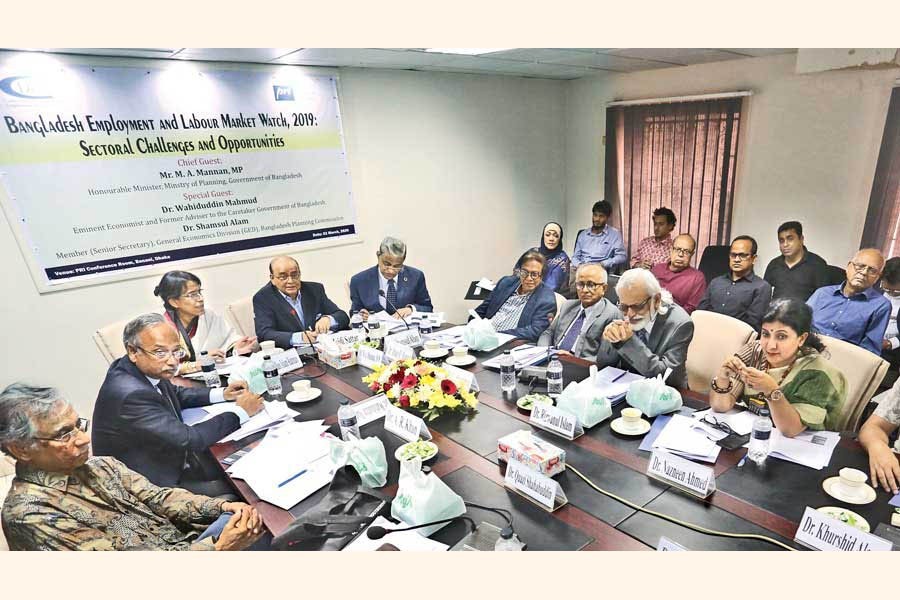Employment growth in the manufacturing sector has decelerated in recent years, accelerated by investment in higher productivity, according to an economist.
Rizwanul Islam, visiting senior fellow of the Centre for Development and Employment Research, said the establishment of larger or medium-sized industrial units was on the rise, which contributed to the modernisation of the manufacturing process with an emphasis on productivity.
"Annual employment growth has declined sharply in recent years," he said.
The growth rate was 3.3 per cent during 2005-10, which slumped to 1.7 per cent during 2010-16, said Mr Islam.
During the same period, the annual employment in the manufacturing sector came down to 4.6 per cent from previous 6.3 per cent, he added.
He depicted the picture while presenting a paper at a seminar on "Bangladesh Employment and Labour Market Watch 2019: Sectoral Challengers and Opportunities."
Dhaka-based think-tank Policy Research Institute organised the seminar at its office in the capital.
For instance, Mr Islam said the employment in the ready-made garment sector has either stagnated or declined as the number of factories came down to 4,621 from over 5,000 in the last 10 years.
"… Unemployment rate is higher among educated youths compared to the uneducated," he added.
His study showed women participation rate in the labour force is stagnant because of the wage difference and persistent gender inequality.
He also said employment in overseas market is critical, but unpredictable.
In the paper, he said textiles, apparels, pharmaceuticals, furniture, leather and leather products witnessed lower or negative growth in employment compared to the period of 2005-06 to 2015-16 and 2015-16 to 2016-2017.
He said larger industrial units in garment and many other sectors are adopting labour-saving technologies.
"This has contributed lesser growth in jobs," he noted.
Mr Islam said the country's incentive policy is discriminatory.
The policy level incentives should be provided to other export-oriented and labour-incentive sectors to overcome the employment problem, he argued.
The centre's executive chairperson Rushidan Islam Rahman said that the number of overseas jobs was increasing because the government failed to achieve the employment generation goal mentioned in the 6th and 7th five year plans.
Of the total valuable labour force during 2016-18, only 55 per cent could be accommodated, but during 2006-2010 the rate of local employment absorption was 71 per cent, she said.
She said that it was a good sign that overseas employment was picking up momentum, "but remember, we send unskilled labour in the world market and the need of such manpower will come to an end in the coming days with robotics and other technology."
In contrast, skilled manpower from other countries comes to Bangladesh and takes away billions of dollars each year. "This is not right," she said.
PRI chairman Dr Zaidi Sattar, however, said while 40 per cent or 26 million of the labour force is currently employed in the agriculture sector, its share in economic output is only 13 per cent.
"So there is a vast pool of under employed people in our rural areas. With proper training, this surplus labour can be employed elsewhere," he said
General economics division member Shamsul Alam, said the government gave permission for setting up universities based on needs to meet the demand for skilled manpower.
"There are universities for garment, textiles, fashion, leather and ceramic studies then why there will be problem for skilled manpower in the different industries," he said.
The private sector people should pay more attention to increasing the educational level of such specialised universities, he added.
Echoing Dr Zaidi Satter, he said around 40 per cent labour force is engaged in agriculture, which contributes 13 per cent of gross domestic product.
"It is not desirable," he said.
Planning minister MA Mannan said there are some good signs that the number of technical education graduates has increased from 3.0 per cent to 18 per cent in the last 10 years.
"We're facilitating the skilled labour programme and hope it will bring better results in the coming years," he said.
He said currently the government policy is focused on import-substitute industries, but it should shift towards export-oriented sectors.


